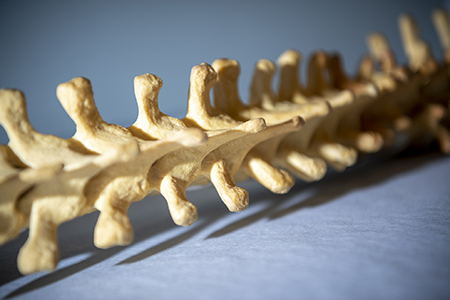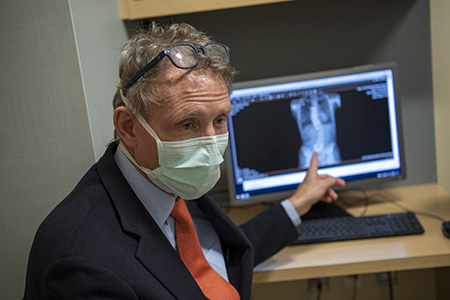Patient EducationFeb | 22 | 2021
Tethering Surgery for Scoliosis: Overview

What is tethering surgery for scoliosis?
Tethering surgery aims to correct spinal curvature (curves in the spine from scoliosis) and maintain the spine’s natural growth, mobility (flexibility) and function (ability to participate in sports and other activities without restriction). It is also called anterior spinal growth tethering or vertebral body tethering (VBT). The surgery involves a minimally invasive approach for placement of screws and a tether along the outer portion of the spinal curvature. As your child grows, the tether gently guides the vertebra (joints in the spine) into a straighter position. Minimally invasive surgery involves the use of an endoscope (a thin tube with a camera on one end) that allows the doctors to perform surgery through very small incisions.

How does tethering differ from other types of scoliosis surgery?
In the past, spinal fusion surgery was the only way to correct spinal curvature. Spinal fusion surgery involves an open procedure (when doctors cut through the skin, muscles and tissues to see all organs, bones and tissues involved in the surgery), usually performed through a long incision over the back. Multiple screws and two rigid metal rods are used to straighten the spine. The additional use of bone graft (bone taken from another part of the body) to achieve a fusion is required. Though the rods keep the spine straight, they also limit the spine’s natural movement. Later in life, the stiff spinal fusion can cause degeneration (excessive wear and tear) of the discs above and below the metal rods. This can lead to back pain and other problems that require additional surgery or surgeries.
What are the advantages and disadvantages of tethering?
Advantages
- Children and teens are still growing. Tethering uses children and teens’ natural growth to correct spinal curvature over time.
- Tethering can be performed in the thoracic spine (the upper part of your back, or chest region, that has ribs on either side) and/or in the lumbar spine (the lower part of your back that does not have ribs).
- Unlike spinal fusion, tethering allows for more flexibility and movement in the spine. Keeping as much natural movement as possible lowers the risk of wearing down the discs and vertebra later in life. This way, your child can safely take part in their favorite physical activities. This can include dance, sports or different types of exercise.
- Less time out of school and other activities. Most children can return to school 2-3 weeks after surgery. They can return to other activities in 3 months.
- Less invasive procedure. Tethering is a minimally invasive surgery performed in the thoracic spine using an endoscope inserted between the ribs. An endoscope is a small surgical camera that allows tethering to be performed though 3 tiny incisions. Tethering in the lumbar spine is performed using a mini-open procedure using one small incision.
- Chest tubes are rarely needed after tether surgeries. Because one lung must be partially deflated during tethering surgery, reinflation of the lung is required at the end of the procedure. Reinflation of the lung requires a chest tube, which many tether surgeons leave in place for several days. A chest tube is a hollow tube placed into the chest to help re-inflate the lungs. At MGfC, doctors use the chest tube temporarily while in surgery, but then safely remove it before your child wakes up. Because chest tubes have been described by some as a garden hose in your chest, it is preferable for children not to wake up with a chest tube between their ribs. Your child may be much happier and more comfortable after tethering surgery without a chest tube.
Disadvantages
- Tethering surgery cannot be used on all scoliosis curves. Some curves are too large or too stiff for tethering to be effective. Some curves are too high in the chest to safely reach with a tether. And some rarer types of scoliosis (like congenital scoliosis and kyphoscoliosis) have unique features that make tethering a less attractive treatment option.
When is the best time for my child to have tethering?
The best time for your child to have tethering is when they still have some growth left in their spine. The most typical age for tethering is between 10-15 years old. In certain circumstances, it can be considered in children under the age of 10 years and even in the late teenage years. The most accurate assessment of growth, however, is not determined by your child’s age. It is determined by growth centers (parts of the bone that are still growing and maturing) in the bones of the pelvis and hand. Your child’s care team can help figure out how much growth your child has left through bone age tests that involve simple X-rays of the hand and pelvis.
Did you know…?
The most common type of scoliosis in children and teens is adolescent idiopathic scoliosis. For many years, the cause of this type of scoliosis was not known. More recent research has shown it to be a genetic or familial condition. Almost 9 out of every 10 people with scoliosis have adolescent idiopathic scoliosis.
Rev. 2/2021. Mass General for Children and Massachusetts General Hospital do not endorse any of the brands listed on this handout. This handout is intended to provide health information so that you can be better informed. It is not a substitute for medical advice and should not be used to treatment of any medical conditions.
-
![]()
- Orthopaedic Spine Surgeon
- Pediatric Spine & Scoliosis Surgeon
-
![]()
- Pediatric Surgery
- Department of Surgery
Related Pages
Type
Centers and Departments
Patient Resources
Patient resources for Pediatric Orthopaedics
Meg's story: Tethering surgery helps dancer with scoliosis stand tall again
Without critical surgery to correct her scoliosis, Meg's performance career almost ended early. Three months after surgery, Meg returned to the stage.
Appointments and Referrals
Request an appointment or second opinion, refer a patient, find a doctor or view test results with MGfC's secure online services.



